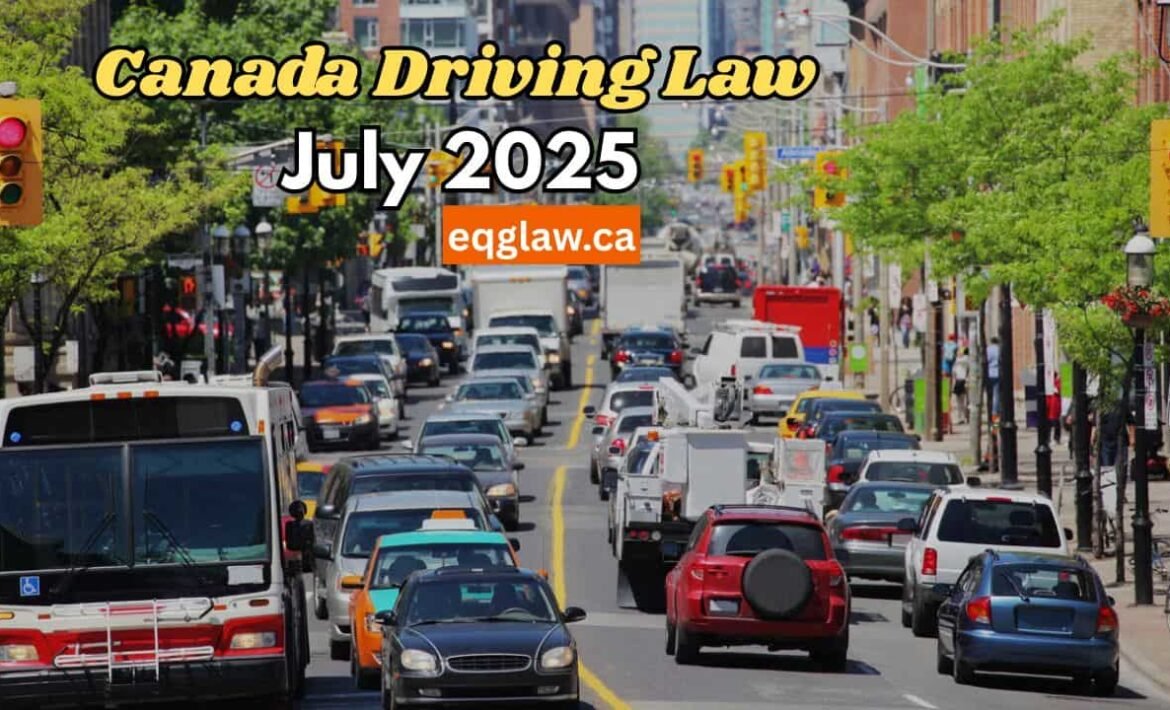Canadian officials update traffic laws and public safety rules for 2025 to improve safety, manage traffic efficiently, and align with modern driving trends. Suppose you first visit a local driver, a commercial driver, or Canada for the first time. In that case, it is necessary to familiarize yourself with new statutory provisions.
The following is the summary of the most essential Canadian driving laws as of July 2025:
1. Total ban on handheld units

What this means:
-
You can no longer catch the phone, not even at the red light.
-
It is also forbidden to use a SmartWatch while driving.
-
The fines can range from $300 to $1000, depending on the province and the number of crimes.
-
Repeat fractures result in license suspension and downpoints.
-
Tip: Invest in a dashboard mounting or Bluetooth system to keep you safe and follow the rules.
2. Revised Impaired Driving Rules
The drinking and driving laws are updated to reflect a zero-tolerance approach, especially for new drivers and commercial operators.
Main highlights:
- Legal blood alcohol content (BAC) is still 0.08% for experienced drivers.
- The new driver, less than 22, and commercial drivers should maintain a 0.00% BAC.
- Administrative suspensions now apply to 0.05% in many provinces.
- The police are allowed to request roadside breath tests for no other reason.
Penalties include:
- Immediate license suspensions.
- Vehicle impoundment.
- Criminal charges for repeat offences.
3. New rules for commercial drivers
Commercial and transport managers are required to follow updated TimeService (HO) rules to reduce fatigue accidents.
The new rules include:
- Runs for a maximum of 13 hours in 24 hours.
- Minimum eight hours of guard between shifts.
- Strict logbooks and requirements for electronic logs (fire).
Drivers working in remote areas such as Northern Canada may be eligible for exceptions but must still follow the rest of the rules.
4. Senior driver’s license renewal
Senior drivers aged 70 and above face more frequent testing and evaluation during license renewal. The move aims to ensure traffic safety by supporting aging drivers who are still capable of driving.
- At age 70, license renewals occur every two years.
- Medical reports, vision tests, and possibly written or road tests are now required.
- At age 80+, annual renewals may apply depending on the province.
Note:
The goal isn’t to get seniors but to support safe and responsible driving.
5. Emergency & Roadside Vehicle Protection Laws
To protect roadside workers and emergency responders, the “Move Over” law has been expanded and enforced more aggressively.
To drivers:
- Slow the tug, police, fire, or ambulance vehicles at a safe speed while passing with a bright light.
- If it is safe to do so, go to another path.
- A fine of $400 or more, with 3-6 demerit points in many provinces.
6. Healthy driving bans
- Medical conditions that can affect driving ability, such as epilepsy, vision loss, and cognitive impairment, are now more closely monitored.
- Doctors are legally required to report to the provincial officials
- Drivers with conditions such as diabetes, seizures, or dementia may require medical withdrawal before renewing the license.
If you have health conditions, be active. Keep the health documents up-to-date and contact your doctor about your driving ability.
7. Demerit marks and license suspension
The traffic violations point system remains active and updated for better tracking.
For example:
- Speed, unfair path changes, and distracted driving are now considered highlights.
- Reaching the limit (e.g., 15 points in Ontario) leads to an automated license suspension.
- New drivers can be suspended for low points.
- Check your local Ministry of Transportation website for province-specific thresholds.
Summary of significant changes in July 2025
Legal Update Details
Distracted driving: total restrictions on handheld devices
Poor driving: Zero tolerance for new and commercial drivers
Senior runs Medical and vision tests on 70+
Commercial driver: Updated driving/relaxation time limit
Tugs, tools, and emergency vehicles continue with extended laws to include vehicles
Health restrictions: Mandatory medical disclosure by doctors
Point system: Strict tracking and fast suspension
Last idea: Be updated, be safe
July 2025 Driving in Canada reflects a national effort to promote updated traffic safety, embrace technology, and support driving for people of all ages.
While the law varies slightly from province to province, the overall goal is fewer accidents, safer roads, and better driving habits for everyone.
Regularly check the rules of your province.
Take refreshment courses if necessary.
Never drive distracted or impaired.








